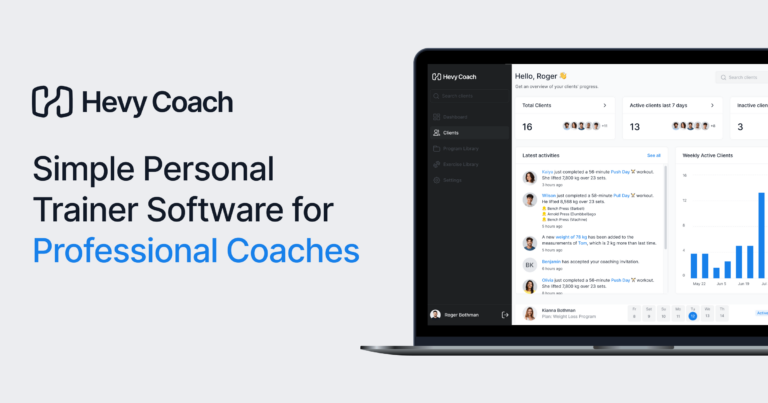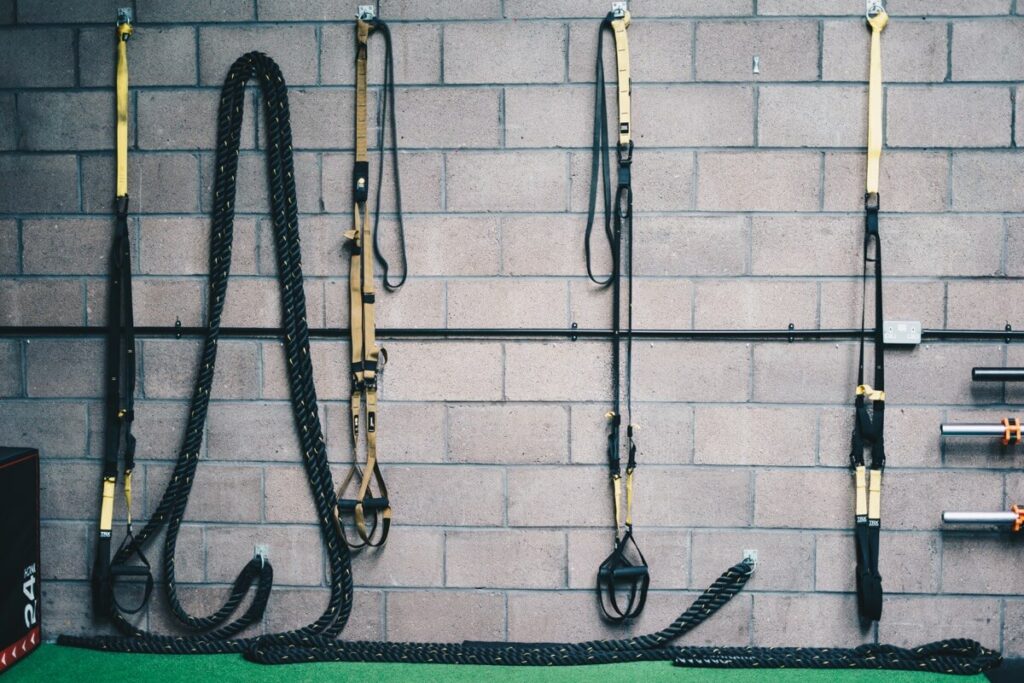Whether you work at a gym, have your own studio, or are thinking about transitioning to online personal training, you need the right tools to be successful.
Good tools allow you to communicate with your clients more effectively, waste less time on non-essential tasks, provide superior service, track clients’ progress, communicate efficiently, and much more.
To that end, we’ve compiled this guide to share the best tools from several broad categories:
- Workout planning and programming
- Fitness tracking
- Strength training & cardio
- Client management and communication
- Meal planning and nutrition
- Business management and marketing
Read on to learn what tools and personal training software you need in your practice.
What are the Best Tools for a Personal Trainer?
The best tools for a personal trainer come in several categories: fitness tracking, strength training and cardio, client management and communication, meal planning and nutrition, and business management. Popular examples include Hevy Coach, MyFitnessPal, EatThisMuch, Canva, Aweber, Hootsuite, and Quickbooks.
Workout Planning and Programming Tools
Providing safe, engaging, and effective workouts is arguably the most crucial part of a personal trainer’s job. People hire trainers precisely because they want someone to break it down for them and guide them on their training journey.
Putting together a workout plan might seem straightforward to you, but that can be highly frustrating and confusing for trainees because a thousand questions come up:
- What exercises to do?
- How to arrange said exercises?
- How much weight to lift?
- Is 8 to 12 reps the best range for muscle gain?
- How often to test 1RM strength?
- How many sets to do?
- Should I train each muscle group once per week? Or perhaps twice?
That said, even if you know how to create effective training programs, doing so from scratch every time is inefficient. One good solution is to leverage workout templates. These are simple spreadsheets or documents with information and directions that make it easy to build workout plans based on goals: hypertrophy, strength, etc.
The primary tool we recommend in this category is Hevy Coach––an all-in-one platform that:
- Allows you to build routines and assign them to clients
- Make changes to clients’ training programs when necessary
- Send surveys for clients to fill up
- Send and receive files (spreadsheets, videos, photos, PDFs, etc.)
- Keep track of all clients in one place to see how consistent everyone is and if they are making good progress
- Communicate with each client through chat without having to switch between apps or look for emails
Our goal is to have the entire coaching experience on a simple platform. That way, you don’t have to waste time switching between tools. Everything is in one place, and you can easily access your chat history if you need to follow up with clients or double-check personal details.
A simple log book can be an alternative for old-school personal trainers. You can record each client’s workouts and track their performance over time.
The disadvantage is that a log book doesn’t offer the same functionality and is only helpful for recording training data. Plus, tracking your clients can be more challenging if your roster consists of five or more people. You must constantly flip between the pages to compare your client’s data.

Try Hevy Coach
Intuitive personal trainer software, with a world class experience for your clients.
30 day free trial, no credit card required
Fitness Tracking Tools
Aside from developing an effective training plan, tracking each client’s progress is necessary for keeping them motivated, accountable, and in a better position for success.

Each coaching process should begin with an initial assessment, where you establish a baseline. The objective is to write down values like:
- Personal information (name, age, gender, occupation, etc.)
- Body weight and body fat percentage
- Circumference measurements (chest, arms, waist, thighs, etc.)
- Posture (normal, lordosis, kyphosis, etc.)
You must also perform a functional movement screening to determine how well your new client can perform squats, lunges, straight leg raises, etc. Performing these tests provides trainers with valuable data and tells them what strengths and weaknesses their clients have.
Writing all that information down and following up with clients every four to eight weeks is necessary to ensure they are moving in the right direction. After all, personal training is about producing results for clients, so it wouldn’t make sense to perform just one assessment and be done with it.
For example, if a client has significant lordosis when they start working with you, their posture should improve over time. Therefore, part of your job is to prescribe strength and mobility activities that help clients resolve such issues.
Similarly, if a client can only do four push-ups during their initial assessment, they should be able to do at least 12 to 15 a few weeks later.
Fortunately, keeping track of your client’s progress isn’t that difficult. It’s more a question of knowing what variables to track. Here are the four primary ways:
- Body weight, especially for clients interested in weight loss
- Circumference measurements, performed with a tape measure for additional data on your client’s body composition
- Gym performance and progress
- Progress photos to gauge visual changes (these can be highly motivating for clients)
Additionally, it’s helpful to track your client’s activity level, typically in the form of daily steps taken. Your clients can use a phone app or wearable technology like Fitbit. Doing so can make it easier to determine how many calories your clients should eat based on their goals (more on that below).
When tracking gym performance, having your clients log their workouts in an app like Hevy makes it easier to gain full access to their data and see what they are doing:
- How many sets they perform
- How long their rest between sets
- How much weight they lift
- What exercises they perform
- How long each workout lats
- How it all changes over time (if at all)
For example, as you start personal training sessions, instruct your client to open the app and log everything they do. It’s an excellent habit for clients to develop early on.
For body weight, one option is to create a Google spreadsheet and provide access to your client. They can write each weigh-in there and calculate the weekly average.
But What About Body Fat Percentage?
Fitness professionals often wonder if they should keep track of body fat percentage and if that number has actual value. For example, if a client wants to lose weight, would their body fat percentage matter if they steadily lose weight and look better visually?
The problem with body fat percentage is that there is a degree of inaccuracy, regardless of the testing method. For instance, skinfold calipers can be somewhat accurate, but the technique used for the measurements and the trainer’s experience will have a considerable impact. Ten trainers can measure the same person and come up with ten body fat percentage values.
Even a DXA scan, considered the most accurate method, can be off (1).
If you want to track your clients’ body fat percentage, do it. Here is a guide you can read about calipers and testing methods you can try. However, understand that getting good at taking these measurements takes time, and they won’t be entirely accurate.

Try Hevy Coach
Intuitive personal trainer software, with a world class experience for your clients.
30 day free trial, no credit card required
Strength Training and Cardio Tools
There is a lot of personal training equipment. Still, such items will generally only be necessary if you offer coaching in your own personal training studio, at your home, or in clients’ homes. If you work at a gym, especially a larger one, you won’t need to get essential personal training equipment for your clients to have good workouts.
Here is a list of essential personal trainer equipment if you’re just starting and are on a tight budget:
1. Exercise Mats
It’s best to have a couple of exercise mats for your clients to engage in effective activities on the floor: lying leg raises, plank, push-ups, donkey kicks, floor presses, etc.
Despite looking identical to yoga mats, exercise mats are slightly different and serve a unique purpose. Exercise mats are smoother, typically larger, and thicker.
The advantages of an exercise mat are that it provides comfort and protects trainees from a hard floor, reducing the risk of nagging aches or injuries. Plus, exercise mats don’t take up much space. You can roll them up and store them in a corner when you don’t need them.
2. Resistance Band Set
Resistance bands are highly beneficial for several reasons. First, they allow trainees to do many effective exercises to target all the major muscle groups in the body:

- Chest – flyes and presses
- Shoulders – overhead presses, lateral raises, front raises, face pulls, etc.
- Triceps – overhead extensions, kickbacks, etc.
- Back – lat pulldowns, horizontal rows, bent-over rows, lat pullovers, etc.
- Biceps – bicep curls, hammer curls, crucifix (single-arm) curls, etc.
- Quadriceps – banded squats, Bulgarian split squats, etc.
- Hamstrings – banded leg curls, Romanian deadlift, etc.
- Glutes – glute kicks, banded glute bridge, standing glute kickback, etc.
Second, bands are great for warm-up and light mobility work. Each resistance band set has thinner bands that don’t offer as much tension, making them ideal for lighter sets that prepare your clients’ muscles for training.
Third, you can use bands to make specific resistance training exercises easier or more challenging.
For example, you can tie a looped resistance band over a pull-up bar and let it hang like a noose. Then, your client can place both feet inside the noose, grab the bar, and perform band-assisted pull-ups.
Alternatively, position the same looped band behind your client’s back, wrap both ends over their hands, and have them do push-ups. The additional resistance would make the classic chest builder more challenging and effective.
Plus, the beauty of resistance bands is they are an affordable piece of equipment. You can grab an entire set consisting of several bands, a pair of handles, a door anchor, and an ankle strap for less than $100. It typically comes in a small bag you can store in your personal training studio or home.
3. A Pair of Adjustable Dumbbells
Trainees can do countless effective exercises with just a pair of dumbbells. However, purchasing and storing an entire rack is expensive and difficult, so a single pair of adjustable dumbbells is a far more practical solution.
Even premium-grade adjustable dumbbells cost less than an entire collection. Plus, they take up far less space, which is beneficial if you offer your services from your home gym or personal training studio.
For example, the Bowflex SelectTech 1090s go from 10 to 90 lbs, replace 17 sets of weights, and come with a neat dial system that makes it almost effortless to switch between loads during training.
4. Adjustable Kettlebell
An adjustable kettlebell can be a good workout solution because you can select the appropriate load for each exercise.
Instead of spending money on multiple kettlebells, one to two adjustable ones will do the job.
Titan Fitness, REP Fitness, and Bowflex offer quality kettlebells at an affordable price. If you’re working with a tight budget, you can even consider a tool like Kettle Gryp. It works by wrapping over a dumbbell handle and turning it into a kettlebell.
5. Suspension Training Kit
A suspension trainer, like Total Resistance Exercise (TRX), is another excellent option for an effective full-body workout. Like other essential tools on our list, TRX is inexpensive and compact, which means it’s ideal for storing in your home gym or small rented studio.

The beauty of TRX is that it allows trainees to do countless effective exercises to build muscle, core strength, stability, and coordination by leveraging their body weight.
6. Pull-up Bar
A pull-up bar is another good investment for your home gym or personal training studio. You can get a wall-mounted one or one you attach to a door frame.
Your clients can do pull-ups, chin-ups, dead hangs, scapular pull-ups, L-sits, hanging knee/leg raises, and other movements where they leverage their own body weight.
Aside from being fun and engaging, these exercises develop real-world functional strength and don’t require fancy gym equipment.
7. A Jump Rope
A jump rope is one of the simplest tools to improve cardiovascular fitness, muscle coordination, and agility.
Jumping rope is a fun way to do cardio, enjoy a dynamic training session, burn many calories, and develop explosiveness (2). Plus, it looks infinitely cooler than walking on a treadmill.
8. Medicine Balls
A medicine ball is not mandatory, and it might not be as helpful for all of your clients, but it can still be a valuable addition to your personal training equipment arsenal.
Under the right circumstances, a medicine ball can allow for a fun whole-body workout that burns many calories, builds muscle, improves your clients’ explosiveness, and develops core strength.
9. Foam Roller
Foam rollers are self-massage tools that allow clients to practice self-myofascial release and reap multiple benefits.
Foam rolling is a good way to warm up before training, improve range of motion, and potentially even reduce delayed-onset muscle soreness (DOMS) following a demanding training session (3).
It’s better to pick up a softer foam roller because more clients can use it.

An alternative to foam rollers is a massage ball. It offers the same benefits but allows for a more targeted massage because it focuses on a smaller target area.
10. First Aid Kit
A first aid kit is one of these items it’s good to have and not need than to need and not have.
If you’re an independent personal trainer or plan on becoming one, having a first aid kit is good because training accidents can happen. For example, if a client scrapes themselves on the knurling of a barbell, it’s good to have tools to disinfect the area and patch them up.
Plus, some clients prefer working with first-aid-certified personal trainers, so it doesn’t hurt to look into the subject because these skills could be handy at some point.
Client Management and Communication Tools
As a fitness professional, you probably agree that client management and communication can be frustrating. Keeping up with clients, answering their queries, following up, double-checking to confirm scheduled personal training sessions, and organizing your roster can be time-consuming and confusing.
On top of that, dealing with clients across multiple platforms can make you lose track of crucial information, forget to follow up, and struggle to track their progress and adherence. A personal trainer who makes the rookie mistake of managing clients with multiple tools is in for a bad time.
For example, if you use Instagram DMs for one client, email for another, and Skype for a third, you would waste time switching between platforms and energy to recall where you communicate with every person.
Everyone can manage two to three clients across several platforms, even if the approach is inefficient. However, doing so becomes increasingly challenging, bordering on impossible, as your roster grows to 5 or 10+ clients.
The solutions are obvious:
- Reduce the number of tools you’re using
- Simplify the process as much as possible
- Come up with a step-by-step process for signing new clients and integrating them into your system
Unfortunately, doing so is easier said than done. For example, you could move all of your client communication over email, where you would have an account just for client correspondence. That option is infinitely better than improvising, but it also comes with some drawbacks.
Back-and-forth emails are straightforward to track, but what happens when you have to share training programs, track progress, answer quick questions, and provide nutritional guidance? A simple series of email exchanges can morph into a convoluted mess that makes it impossible to keep track of everything.
Imagine how enormous email exchanges can become if you work with a client for several months.
One tool that can help is Acuity Scheduling. The tool automates scheduling, reminders, and payments, freeing up your time and allowing you to focus on other essential aspects of running a successful practice.
The way it works is quite simple:
- Sign up for the tool. You can use a Google account.
- Set up your scheduling page by filling up the necessary fields.
- Set up your first appointment type by writing down a name, duration, price (optional), and type (1:1 or group class).
- Set up your availability (time zone, dates, and times).
- Connect a payment platform like Stripe or Paypal (optional).
Acuity Scheduling is a decent tool for scheduling training sessions, especially if you prefer to get paid online. However, despite the benefits, we still face the same problem: you must use several tools to coach your clients.
For these and other reasons, the best solution is to use a coaching platform to share training programs with your clients, make quick adjustments, track performance and consistency, and share files (spreadsheets, instruction videos, PDFs, etc.).
A platform also makes it easier for your clients to respond to your messages, fill up spreadsheets (nutrition, training, progress-tracking, etc.), and refer to your older messages without wasting hours. In other words, you need an all-in-one solution.
Using a platform is particularly important for online personal trainers because it will be their primary or only communication method. Each interaction needs to be valuable and efficient.
Hevy Coach is the number one platform for coaches and personal trainers. It has a simple design and a dashboard that includes all the necessary features for your coaching practice:
- Communicating with your clients in one place
- Sending all the necessary files and having clients return some of them (e.g., filling up a tracking spreadsheet)
- Sending training programs and making adjustments on the go
- Tracking your clients’ adherence and performance
Clients are invited to download the Hevy app to access the assigned workouts and log their performance. As a trainer, you will have full access to their training: what exercises they’ve done, how many sets, the number of reps, their rest periods, how long the workout lasts, etc.

Try Hevy Coach
Intuitive personal trainer software, with a world class experience for your clients.
30 day free trial, no credit card required
Meal Planning and Nutrition Tools
One of the biggest mistakes you could make as a coach or personal trainer is to focus solely on your client’s gym efforts and not pay attention to their nutrition.

Diet and training influence one another more than most people imagine. You could deliver the best possible training program that accounts for many details like injury history, available equipment, life stress level, and fitness goals, but it would all be in vain if your client doesn’t know how to eat.
So, in addition to guiding your clients at the gym, pay close attention to their nutrition and eating habits. Helping clients gain control of their diet will allow them to see better results, stay motivated, and reach their goals more quickly.
You have two primary options to go about it. Let’s review them and see the benefits and drawbacks of each.
1. Create Meal Plans
Creating meal plans for clients based on their nutritional needs can be an effective way for them to reach their goals. The obvious advantage is that your clients don’t have to worry about any diet-related details because their only job is to follow your plan as outlined.
The advantage for you is that you can earn more money from each client.
Some clients prefer that approach because they are busy and cannot be bothered to think about their diet multiple times per day.
However, the approach comes with some drawbacks. First, creating meal plans for clients makes them more reliant on your guidance and more likely to reach out with endless nutrition questions.
Second, following a meal plan is easier said than done. Clients might adhere initially, but it can get tiresome after a while. To avoid that, you must spend a lot of time and energy coming up with healthy, nutritious, and delicious meals and rotating them regularly to keep your clients’ diets sustainable.
Third, it becomes increasingly challenging to adjust meal plans as your clients’ calorie and macronutrient needs change over time. For example, if a client needs to lose weight, they might eat 2,500 calories daily at the start, and you would create a meal plan for them.
However, due to the inevitable metabolic adaptation, your client will need fewer calories to continue losing weight over time (4). Your job would be to return to the drawing board every few weeks to adjust their meal plan, which would require time and energy.
If you insist on creating meal plans for clients, consider a tool like EatThisMuch. Input the client’s calorie needs and dietary preferences (if any), and the app will generate a simple meal plan in seconds.
2. Teach Clients to Track Macronutrients
Teaching your clients to track their nutrition is perhaps the better approach for several reasons:
First, it’s not as time-consuming because you don’t have to create meal plans from scratch or tweak them as your clients’ calorie needs change. You can be less involved in the process and only check in to see how your client is doing, provide recommendations, and answer diet-related questions.
Second, the approach is less expensive for your clients because they don’t have to pay for a meal plan and must do most of the work by determining what to eat and when.
Third, tracking calories and macronutrients allows for far greater dietary flexibility, allowing your clients to enjoy their social life, have meals at restaurants, and not worry about eating a set of specific meals every day. Taking the pressure off in such a big way can make your clients’ nutrition far more enjoyable and sustainable.
Fourth, calorie tracking teaches your clients valuable skills and lessons, including:
- The ability to eyeball food amounts
- Understanding their nutritional needs when chasing goals like fat loss and muscle gain
- Learning to gauge their hunger and satiety better
- Learning to make better nutritional choices daily
Even if your clients stop tracking their calories at some point, they could continue to use these skills to eat better and stay fit for life. In contrast, solely relying on meal plans stops them from developing these valuable skills.
Finally, tracking calories and macronutrients forces your clients to become more independent, which benefits you and them. You don’t have to be as involved in their daily nutritional choices, and your clients must learn to decide for themselves.
One good option for tracking calories and macronutrients is MyFitnessPal. The app has a rich food database and does all the calculations for your clients. Plus, you can access your client’s data and look at the foods they eat, their calorie intake, how much protein they consume, etc.
Related article: 6 Steps to Starting a Personal Training Business from Home
Business Management and Marketing Tools
Between client management, taking payments, having clients sign legal documents, and other obligations, personal training can quickly turn into a nightmare. Having the right tools to manage your business and market your services will save you time, energy, and frustrations now and down the road.

With that in mind, here are five tools we recommend to manage different aspects of your business more efficiently:
1. Canva – to create professional-looking flyers, illustrations, and other visual material for your marketing efforts
Canva is a free online graphics design tool to create flyers, whiteboards, A4 documents, presentations, posts for social media, infographics, logos, and videos.
The tool comes with countless free templates, such as beautiful backgrounds with fonts, holiday-themed designs, and other cool designs you can use to create anything visual your business needs.
Canva also offers elements:
- Shapes (circles, squares, triangles, etc.)
- Beautiful graphics (fitness-related or not)
- Stickers
- Charts
- A rich library of professional photographs
You can find whatever elements you need through their search bar, select what you need, drop it on the design page, and build from there.
Canva also offers a fair bit of flexibility when it comes to tweaking design elements by changing the opacity, picking colors for each element, moving components forward or back, adding text (with a wide variety of fonts and sizes available), and much more.
The beauty of Canva is that it is effortless to use, even if you’re not the biggest artist. Its rich library of ready-to-use elements makes Canva an excellent tool for creating cool designs in minutes.
2. Hootsuite – to create and manage your social media marketing material across multiple platforms from a single dashboard
Using social media to market yourself and grow your audience is a great way to land more clients and even transition into online personal training if you wish.
The only problem is that managing your profiles across multiple platforms can take time you could otherwise use to educate yourself, discover new ways to improve your service and serve your existing clients.
With Hootsuite, you can take great care of your social media profiles and get better results in less time. Some cool features of the platform include:
- Suggestions for the best time of day to publish
- Giving you ideas for cool captions you can use to engage more people
- Bulk schedule dozens or even hundreds of posts in advance, essentially putting your social media profiles on autopilot
- See your entire publishing schedule in your calendar to identify potential gaps
- Get the best hashtag suggestions for each post
Most importantly, Hootsuite allows you to do everything in one place, which is far more efficient and makes coordinating your posts across multiple social media platforms easier.
Additionally, Hootsuite’s engagement feature allows you to stay on top of social media developments without having to scroll through hundreds of posts from other people. You can see other people’s publications and comments from your dashboard and respond more quickly.
Suppose you get many direct messages from your followers and struggle to reply on time. In that case, Hootsuite allows you to set up automated replies and even whole conversations, thanks to the chatbot capabilities.
3. Quickbooks – to keep track of your business earnings and expenses and organize your finances
As a personal trainer, you must learn to keep your finances organized and have a clear understanding of your earnings and expenses, especially if you’re running your own business.
Quickbooks is an accounting software and solution that includes all the tools you need to pay taxes, bill clients, track revenue and expenses, and more. One great thing about this tool is that you can use it across multiple devices and stay on top of things, regardless of where you are.
The Simple Start plan is ideal for small businesses. It comes with a 30-day free trial and costs around $150 for the entire year. It includes:
- Sending invoices to clients
- Tracking GST and VAT
- Tracking incomes and expenses
You can also connect your business bank account and receive helpful tips and insights that help you save money and run your operation more efficiently.

Try Hevy Coach
Intuitive personal trainer software, with a world class experience for your clients.
30 day free trial, no credit card required
4. Aweber – to build, grow, and engage with an email list of people interested in what you have to say
We’ve discussed the importance of building an audience and marketing your services numerous times. One crucial tactic for doing so is building and maintaining an email list.
An email list is valuable because you’re collecting the contact information of people who have shown interest in what you have to say or offer. In other words, these people aren’t cold leads but engaged followers from your social media profiles, readers from your blog, or Youtube subscribers.
Aweber is an email marketing tool that stores your list of email subscribers, allows you to send out emails to everyone in just a few clicks, and provides in-depth data like:
- What percentage of subscribers open each email you send?
- Who exactly opens your emails, and how many times?
- Do the people who open your emails click links, and if so, which ones?
- Do people complain about your emails and mark them as spam?
- When was the last time a subscriber opened an email from you?
You can also schedule emails in advance and create entire automated series (campaigns) for new subscribers. For example, Aweber can automatically tag new subscribers to receive an email series that ends with you offering your services.
There are other tools you can use to manage your email list. However, Aweber is simpler to use than most, provides a good amount of data, and is free if you have fewer than 500 subscribers on your list.
5. WordPress – to build a professional website and make all the necessary changes without writing a single line of code
Having a website is another effective way to expand your presence online, build an email list, tell people who you are, and let them know how you can help and how they can reach you.
A good website should have three crucial pages:
- An about page that tells readers who you are, where you come from, and what you do; it should also include a personal trainer bio
- A landing page that clearly outlines your services and what clients can get from hiring you; it is best to include your credentials, personal successes (e.g., placing high in a bodybuilding competition), and testimonials from previous clients
- A contact page that quickly tells visitors of your website where and how they can reach you to learn more about your services
While there are multiple platforms, WordPress.org is the most popular website-building platform, used for 810 million websites as of 2023 (42 to 43 percent of all websites).
WordPress has all the functionality you need to assemble your website using one of the many free or paid themes available. The platform is free, but you must pay for hosting, which can be as cheap as $5-7 monthly.
For example, the standard plan by HostGator includes a free domain (the address people type in their browser to find your website), which is typically paid, and only costs $7.95 monthly.
Final Words
Personal trainers can benefit from the right tools like any other professional. Having tools can save you time and allow you to offer superior service without wasting energy on non-essential tasks that don’t improve your bottom line.
For example, using the Hevy Coach platform is an excellent way to keep track of your clients, provide training plans, make the necessary tweaks, ensure they are consistent, communicate, and send all the necessary files from a single dashboard.
For personal training equipment, an independent coach must have essentials like a pair of adjustable dumbbells, a resistance band set, and an exercise mat.
Additionally, you should keep track of your clients’ nutrition and offer guidance to ensure their training efforts pay off. One of the best tools for the job is the MyFitnessPal app. There is no point in training hard only to return home and eat junk food.
With all that said, you don’t have to immediately get all the tools discussed in this guide and start using them. Begin with a couple and experiment to see what you need in your practice. Not all tools are mandatory for all personal trainers.




